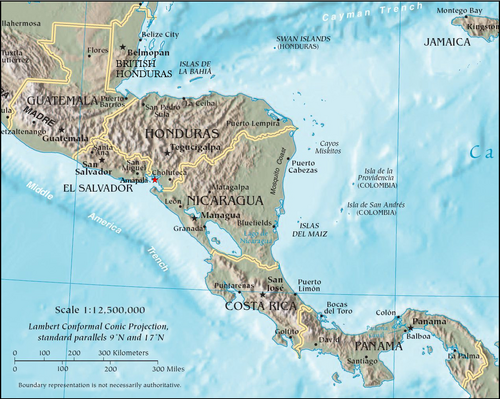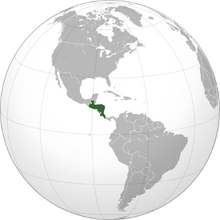Dios, Unión, Libertad (Spanish) ("God, Union, Liberty") | |||||||
| Anthem | "La Granadera" | ||||||
| Capital | Amapala Distrito Federal | ||||||
| Largest city | Guatemala City | ||||||
| Other cities | San Salvador, San José, Tegucigalpa and Managua | ||||||
| Language official |
Spanish (de facto official) | ||||||
| others | Mayan languages | ||||||
| Religion main |
Secular state | ||||||
| others | Roman Catholicism, Protestantism and Mayan religions | ||||||
| Ethnic Groups main |
White (castizo/mestizo) | ||||||
| others | Amerindian (mainly Mayans) | ||||||
| Demonym | Central American | ||||||
| Government | Directorial Federal Republic | ||||||
| President of the Federal Council | |||||||
| Area | 422,614 km² | ||||||
| Established | 1921-1948 | ||||||
| Currency | Peso Centroamericano ($CA) | ||||||
| Organizations | Pan-American Union, League of Nations (Since 1921) | ||||||
The Federal Republic of Central America (República Federal de Centroamérica in Spanish) covers the Central American republics of Guatemala, El Salvador, Honduras, Nicaragua and Costa Rica. Established in 1921, it came as the realization of a decades-long wish to re-establish the defunct political entity of the same name that existed between 1823-1838.
Panama was invited to join the Federal Republic. However, due to pressure from the US, it disallowed itself from the proposal. The Federal Republic claims British Honduras as part of its national territory, continuing the historical demands of Guatemala.
Government[]
The Federal Republic of Central America is organized has a democratic federal state. The division of powers according to the Federal Constitution of 1921 is the following:
- Legislative. The Federal Assembly (Asamblea Federal) is a bicameral legislative body. The Senate (Senado) is composed of five senators per State elected by their State-Republic Legislature. The Chamber of Deputies (Cámara de Diputados) integrated by directly elected deputies. Each state-republic is assigned one deputy for each 100 thousands inhabitants. For electoral purposes each State-Republic is a single electoral district and seats are proportionally assigned according to the electoral results. The Federal District elects one senator and three deputies. The mandate of senators and deputies is of five years with indefinite reelection.
- Executive. the Federal Council (Consejo Federal) is integrated by elected federal delegates. Each state-republic elects a federal delegate for a five year mandate with no immediate reelection. The President of the Federal Council serves for one year and its rotated among its members. The Federal Council designates and removes the Ministers and Sub-secretaries. The following ministries were created: Foreign Relations, Treasury, Justice, Army and Navy, Interior (Gobernación), Public Education, Commerce and Public Works, Agriculture, Labor and Social Welfare, and Public Health.
- Federal Court of Justice (Corte Federal de Justicia) integrated by seven judges. One elected by each the Supreme Courts of the State-Republics and a President, Vice president and Secretary by a common assembly of the Supreme Courts. Its headquarters are in Cartago (Costa Rica). The Court was created in 1907 by the Central American Peace Conference. Its mandate was renew in 1918 for another ten years. In 1921 it was reorganized and made permanent.
Politics of Central America[]
Political parties mainly operate at State-Republic level. They can be classified as:
- old Conservative parties, after the 1930s they diminished their importance or dissolved themselves,
- old and new liberal parties, although some transformed themselves into new reformist parties,
- populist parties or personal political vehicles,
- new reformist parties ideologically akin to left-wing or liberal reformist, Social Democrats or Social Christians,
- Mexican post-revolution style parties that serve to combine conservative reformism, large and middle landowners, business interests and the military. Basically they gathered traditional and new agrarian corporatism interests.
- Communist parties have usually developed a strong presence in the trade union movement, for example amongst banana plantations and railroads. Usually outlawed or curtailed in most State-Republics, they formed factions of new reformist parties in the late 1920s.
Territorial division[]
The territorial division of the Federation is the following
- State-Republic (Estado República), that correspond to the former Central American republics. Each State-Republic has an elected State President and bicameral legislature and independent judiciary headed by a Supreme Court. The mandates of the executive and legislative usually range from four or five years, with restrictions in some cases in the reelection of elected authorities.
- Local government. Corresponds to the municipality (municipalidad). The municipality is public corporation elected every four years by the citizens of the respective zone that it covers. Above it exists other territorial divisions (Departments, except Costa Rica that is divided in Cantons and Provinces) in charged of a political officer designated by the State President.
- For the Federal District (Distrito Federal Centroamericano), the mayor (alcalde) is designated by the Federal Council and a municipality council elected by the residents of the federal district. The FD has the same powers has any other municipality. Its judiciary resides in the Local Court of the Federal District.
Economy[]
Central America is the chief cultivator of bananas and important producer of coffee, sugar, cocoa and cotton. The main North American corporations that trade in tropical fruit are United Fruit Company (UFC), Cuyamel Fruit (until its sale in 1930 to UFC) and Standard Fruit Company (since 1924, renamed Standard Fruit and Steamship Company in 1926). The UFC is the largest producers of bananas and tropical fruits and also the principal employers in the agricultural sector. The influence of the UFC extends to national, regional and local politics, in some cases being accused of buying elections or politicians, and its interest the supreme law of the region.
The UFC also owns the International Railways of Central America and the Great White Fleet. The ships of the Great White Fleet were mainly turbo-electric passenger and cargo liners and reefer ships. In the 1930s it resisted changes to social and labor legislation.
The coffee and sugar producers and exporters are also the main employers and financial groups.
The main road is the the Pan-American Highway (PHA). The PHA runs through Central America, and except for an 87 km of rainforest break, called the Darién Gap, the road links the former republics in a connected highway system of the Americas. The connection of the several isolated railroad lines with freight or passenger service has progressed slowly. This has stopped further works of the Pan-American Railroad in Central America.

Republica Federal Centroamericana 1921



